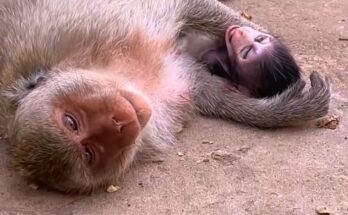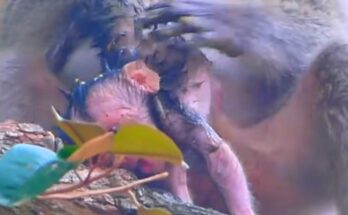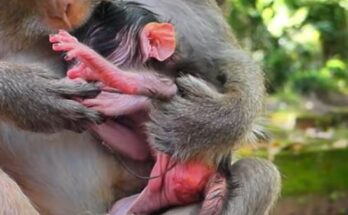A recent viral video showing a mother monkey pushing her own baby out of a tree has stirred strong emotions and bewilderment online. The clip, which captures the tiny infant tumbling helplessly from a branch after what appears to be a deliberate shove from its mother, has left viewers questioning: why would a mother engage in such seemingly cruel behavior?
While it’s easy to anthropomorphize animals and attribute human emotions or motives to their actions, this incident may have deeper roots in animal behavior and survival dynamics.
Primates, like all animals, are driven by evolutionary instincts—survival of themselves and, often, their most viable offspring. In the animal kingdom, particularly among social species like monkeys, maternal care is usually strong. However, under certain conditions, maternal rejection or aggression can occur. These behaviors, as shocking as they appear, are sometimes responses to environmental stress, social hierarchy, or even assessments of the infant’s health or chances of survival.
For instance, if an infant is sickly, injured, or born with a developmental defect, some primate mothers may instinctively abandon or even harm it. This behavior, while tragic, can be viewed as a harsh evolutionary strategy to conserve resources and increase the mother’s chances of raising future, healthier offspring. It’s a brutal reminder of nature’s efficiency over sentiment.
Another possibility lies in the high-stress environments in which many primates live. Habitat loss, scarcity of food, and increased competition within troops can lead to erratic behavior. A stressed or malnourished mother may not have the energy or ability to care for her infant properly, and rejection might follow. In extreme cases, particularly in captivity or highly disrupted ecosystems, mothers have been observed behaving unpredictably.
Social dynamics also play a role. In some species, if a mother is low in the hierarchy, she might face harassment from dominant females or males. This stress can be redirected toward her offspring, or she may abandon the infant to maintain her own safety and position in the group.
Of course, without knowing the specific species, context, and health of the animals involved in this incident, it’s difficult to determine exactly why the mother pushed her baby. It’s also worth noting that monkey behavior is complex. What appears to be an act of cruelty might have been misinterpreted—perhaps the mother intended to nudge the infant to move or catch it during play but misjudged the force or timing.
This video taps into a deep, emotional nerve in humans because maternal care is universally revered and expected. Watching what looks like a betrayal of that bond shocks us. But to truly understand it, we must look beyond emotion and consider the biological, ecological, and social factors that influence animal behavior.
Ultimately, this incident is a stark reminder of the wild’s unpredictability and the sometimes harsh reality of animal life. While our instinct is to cry out, “Oh God, why?” the answer lies not in cruelty, but in a complex web of survival, stress, and instinct.


